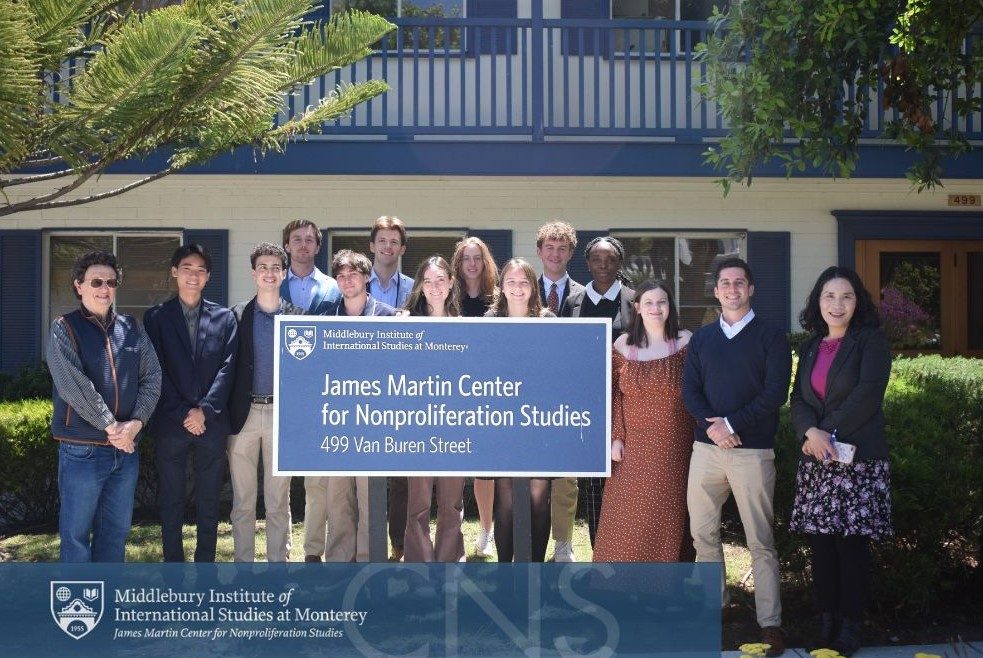
Please find below the slides of final presentations CNS Summer Undergraduate Fellows prepared within their individual research projects.
Click pictures to access slides.
Denuclearization, Peace, & Security Interests Concerning the Korean Peninsula
by Jennifer Kim, University of Michigan Ann Arbor, International Studies (International Security, Norms and Cooperation); Minor: Environment
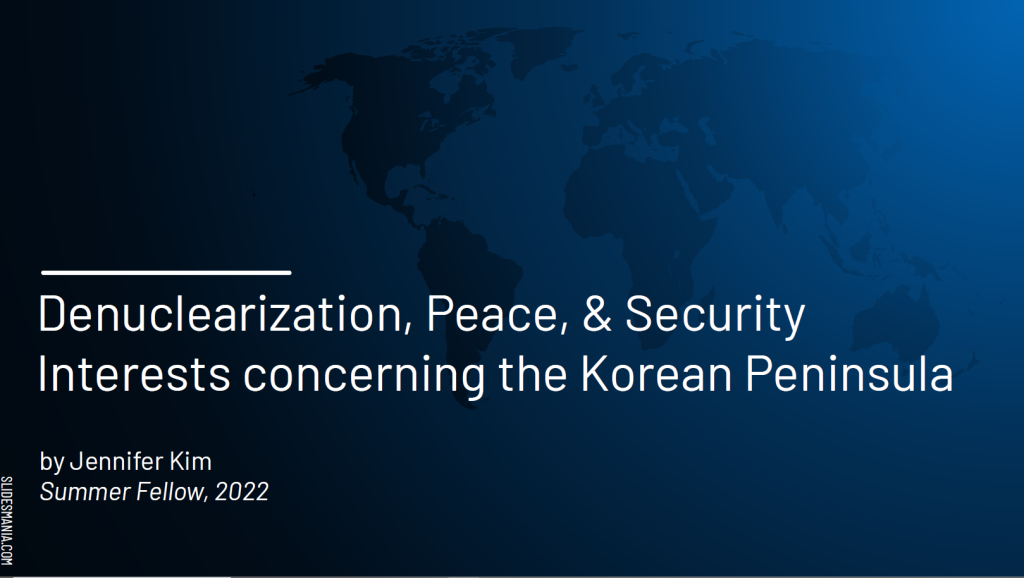
With my independent project, I wanted to re-examine what denuclearization on the Korean peninsula should involve. All of the major parties involved in the issue agree that denuclearization is pertinent to peace; currently, there is also little movement on providing security guarantees that could ease the way for North Korean denuclearization. With tensions rising between the US and China, and with the new Yoon administration moving South Korea closer to the US, the way forward becomes even more complicated. Given these current geopolitical concerns, I examined how the security interests of six nations – North Korea, South Korea, the US, Japan, China, and Russia – influence confidence-building (or breaking) and the work towards denuclearizing North Korea. To this end, I inspected each country’s security interests, building a map of relationships and a list of policies on peace and denuclearization along the way. I also analyzed and connected these policies to current events in the region, such as the Yoon administration’s conversations with Japanese and US officials on North Korea, helping me understand trends in collaboration. Furthermore, I reviewed literature suggesting scenarios and steps for reunification, which provided a conceptualization of peace as a large puzzle that involves many economic, cultural, political, social, and diplomacy-related pieces. From this, I drew three themes. Firstly, whether the outcome in the long-run involves a reunification or a continued stalemate, security guarantees are important to facilitating denuclearization. Secondly, ‘peace’ cannot end with denuclearization or reunification; it involves so many moving pieces that can fall out of place if one state’s security interests are not met. And finally, I am left with the question of how denuclearization can be achieved in a way that addresses some, if not all, of the security concerns of these parties.
China’s Nuclear Buildup: Consideration Beyond Security?
by Steven Zheng, Middlebury College, International Politics and Economics

While the precise size of China’s nuclear arsenal has always been a mystery in the eyes of many people, there is no doubt that China has been actively growing its nuclear stockpile—as the only Nuclear Weapon State (NWS) choosing to do so in the 21st century. Many scholars believe that China’s decision to build up its nuclear weapons is a response to the rising security challenges it has been facing in the recent decade: the nuclearization of DPRK, the American “Pivot to Asia” policy, multiple territorial disputes in East Asia and South China Sea, etc. The argument is certainly true to some extent, yet nuclear decisions are often driven by multiple causal factors. Using Scott Sagan’s three models of states’ nuclear decisions, this presentation will investigate into China’s nuclear policy consideration beyond its security concerns.
Cuban Missile Crisis & Russia’s War on Ukraine: A Comparative Analysis
by Clara Masback, The College of William & Mary, International Relations
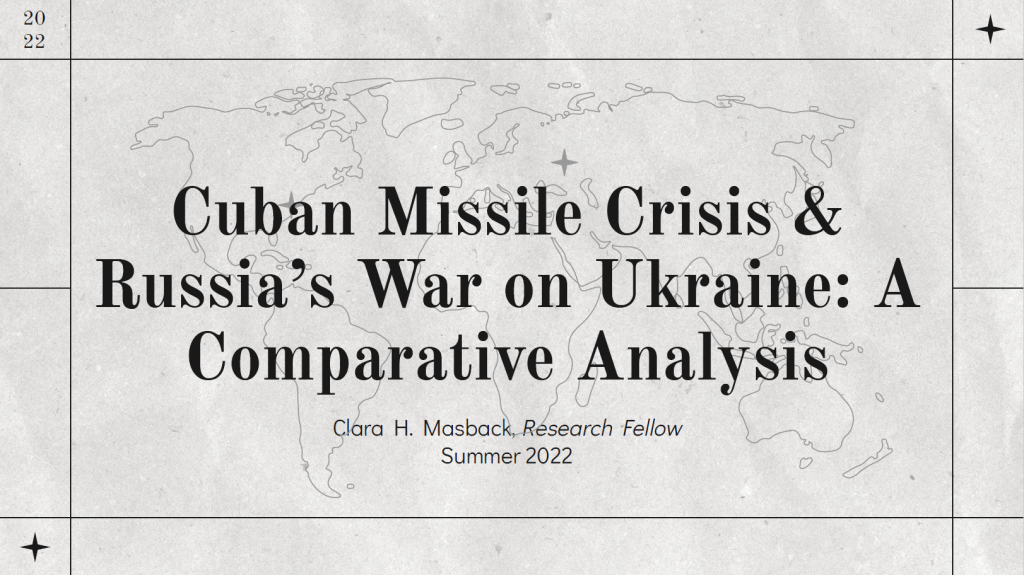
The Cuban Missile Crisis of 1962 created the what is widely considered to be the period of the most heightened tensions between the U.S. and Soviet nuclear powers. While the crisis was terrifying as the world was brought to the brink of a global thermonuclear war, the following years and decades brought forth a series of cooperative arms control measures, including the Limited Test Ban Treaty and Nonproliferation Treaty – which are still in effect today. However, in the past five months, due to the Russian war against Ukraine, tensions have risen dramatically, now holding arms control at significant risk. Is this simply a finite period of peril for bilateral agreements between the United States and Russia, or does it represent a dangerous inflection point? In this project I will endeavor to compare and contrast the Cuban Missile Crisis with the war in Ukraine, and use those observations to opine whether the war will act as a wake up call to the states for further arms control or if we have entered a new era of poor or non-cooperation.
The Role of Geopolitical Factors in Nuclear Deals: Lessons from Iran and the JCPOA
by Caroline Covey, Indiana University, International Studies & Slavic; East European Language and Culture

This research project focuses on how the future of nuclear diplomacy agreements should or may be conducted. I will be focusing on the JCPOA as my case study, as the negotiations that are going on right now could potentially determine the future of the nuclear order as we currently know it. The JCPOA was signed with good intentions to prevent Iran’s possible acquisition of enough highly enriched uranium and plutonium to create nuclear weapons, despite being a signatory as a Non-Nuclear Weapon State to the NPT. However, domestic politics and differing leaders has led to the unilateral withdrawal by the United States in 2018 from the deal, and the subsequent Iranian violations, starting in 2019. As the years have gone on, Iran has now enriched uranium-235 up to 60 percent and is rapidly inching towards the decision to create a nuclear weapon, making the possible renewal of the JCPOA pertinent. However, outside geopolitical issues, such as domestic politics, Iran’s ballistic missiles, the designation of the Islamic Revolutionary Guard Corps as a Foreign Terrorist Organization, and Iran’s influence in terrorist activity abroad is halting the success of a nuclear agreement. Therefore, I would like to consider whether outside geopolitical factors, such as the ones mentioned, should be included in nuclear deals or if such agreements should only focus on the nuclear issues at hand. Which set of issues take precedence? Does the agreement to one set of issues influence the other set? As JCPOA talks are rumored to ultimately fail, and as Iran continues to hedge towards nuclear weapons, this is an extremely pressing and complex issue.
Iranian Nuclear Hedging After the JCPOA
by Leo McMahon, Brown University, International and Public Affairs (Security) and Classics (Greek and Latin)
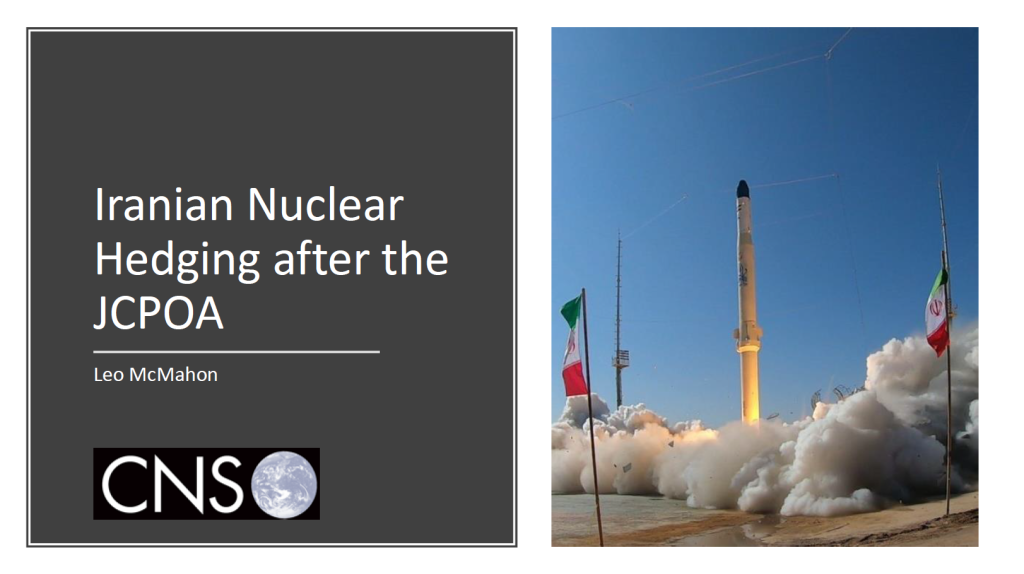
As successive rounds of negotiations fail to make progress, it is becoming increasingly clear that the JCPOA with Iran is a moribund agreement. Nevertheless, it is not at all clear that Iran has decided to produce a nuclear weapon. My research this summer explores one possible strategy Iran might pursue: hedging its atomic bet by enhancing non-civilian nuclear technology without attempting to build or test an actual weapon. A particularly aggressive form of this strategy would involve advancing up to the threshold of weaponization, where Iran could build a weapon within months of a leadership decision to become a nuclear weapons state. My ongoing research studies this strategy on three prongs: First, I have been researching the technical basis of Iran’s enrichment program and its abandoned attempt to build a nuclear weapon before 2003 to understand how Iran could continue technical progress without building a weapon. Second, I have been examining historical parallels to Iran’s situation to see what paths advanced hedging states have taken. And third, I have been reviewing the literature on hedging, deterrence, and proliferation to ascertain some possible consequences of an Iranian hedging strategy.
Improving Counter Proliferation Finance to Counter a Hedging Iran
by Jeanelle Garcia, University of Georgia, International Affairs

Sanctions in Iran from 2011-2015, and again after the U.S. left the JCPOA in 2018, proved to seriously weaken the Iranian economy. However, these targeted, economic, and U.S. secondary sanctions failed to completely change Iranian behavior and moves towards nuclear weapons. When the U.S. left the JCPOA in 2018, Iran responded by making significant strides towards nuclear weapons, decreasing its breakout time from one year to one month. Iran has taken this hedging approach despite the reimposition of sanctions. Governments’ approach to counter proliferation finance (CPF) tends to focus on targeted and economic sanctions, which does not wholly prevent financial transactions supporting proliferation activities (AKA activity-based sanctions). In general, current approaches to CPF are fragmented and weak, and the tool receives very little attention from governments. While many experts have brought attention to these deficiencies, improvement on CPF has been stagnant for many years now. However, comprehensive efforts from the international community to improve this tool, namely the U.S. and EU countries, would be very advantageous given the current hedging of Iran. A stronger approach to CPF means preventing Iran from continuing to engage in illicit financial transactions that support nuclear proliferation. Rather than being overly focused on targeted and economic sanctions, which have been ineffective in preventing Iranian hedging, more focus should be placed on activity-based sanctions. As the future of the JCPOA looks increasingly bleak each day, utilizing tools which will effectively delay the proliferation of nuclear weapons in Iran are more important than ever.
Democracy vs. Nuclear Weapons: Exploring Israeli Nuclear Governance
by Gabrielle Henig, Pomona College, Politics, specialization in International Relations
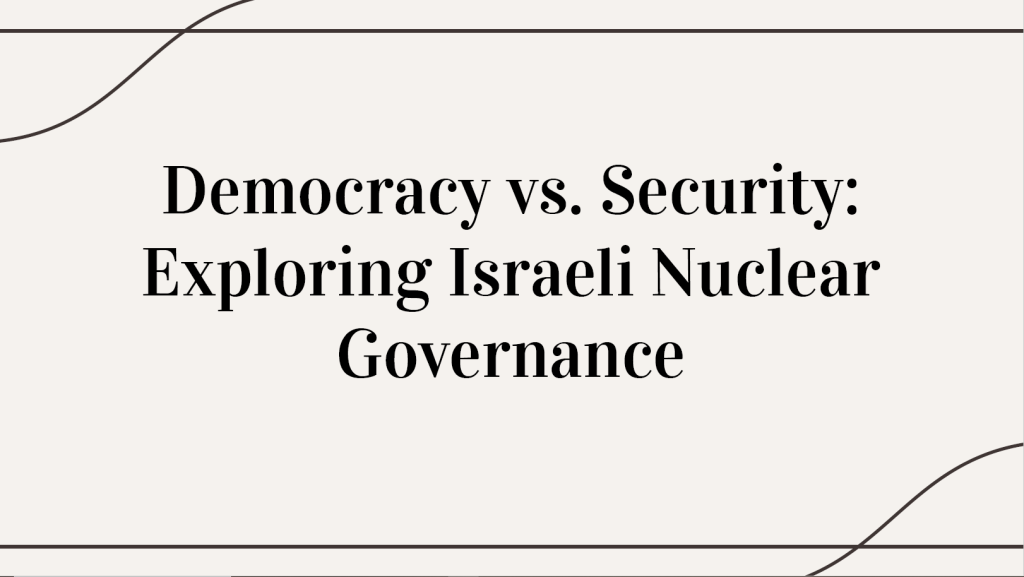
The role that Latin America and the Caribbean Play in Nuclear Disarmament and Nonproliferation
by Maria Espinola Moreno, Middlebury College, Economics and Political Science

The region of Latin America and the Caribbean has played a historic leadership role in raising awareness of nuclear disarmament and nonproliferation issues. The commitment to this common objective of a nuclear-weapon-free world was realized with the signing of the Treaty for the Prohibition of Nuclear Weapons in Latin America and the Caribbean, also known as the Treaty of Tlatelolco (1967). Not only has the Treaty of Tlatelolco played a critical role in the establishment of every other existing NWFZ, but it has also set a really important precedent for two of the most important treaties in the nonproliferation regime: the NPT and the TPNW. To understand why Latin America and the Caribbean have become world leaders in disarmament and nonproliferation education, I analyze the driving principles behind the establishment of the Treaty of Tlatelolco, including the Cuban missile crisis, the potential nuclearization of Argentina and Brazil, and the role played by the governments of Mexico and Brazil, which were the main promoters of this treaty. Understanding this may help us discover how Tlatelolco can contribute to the creation of future NWFZs in regions where there are countries with nuclear weapons and a disarmament process is required.
The Nuclear Legacy in the Marshall Islands: Intersectional Approach
by Deborah Delcid, Trinity Washington University, International Affairs and Political Science

In recent years, several crises have emerged in the Marshall Islands which has drawn international attention to the consequences of nuclear testing. Since 1946, the Marshallese have continuously struggled to regain the land, culture, and rights to health that was stripped from them during the Nuclear Age. After neglecting to warn the Marshallese about the possible consequences of testing, the Marshallese currently face serious climate, food, and health crises. This research explores the historical context of forced relocation imposed on the Marshallese, radiological effects from nuclear testing, and the impact that testing has had on the climate. This is to analyze whether the international and domestic efforts for supporting nuclear testing victims is sufficient to re-stabilize the Marshall Islands.
The Legacy of Nunn-Lugar: A Retrospective of Cooperative Threat Reduction
by Kyle Tucker, Indiana University, International Studies; Russian

The fall of the Soviet Union also meant the disintegration of the Soviet military-industrial complex—opening a window of opportunity for the misuse and dissemination of nuclear weapons, delivery vehicles, and scientific knowledge. US Senators Richard Lugar and Sam Nunn, recognizing this problem, urged a greater appreciation for nuclear nonproliferation in the post-Cold War world. The adoption and subsequent expansion of their Cooperative Threat Reduction Program (CTR) was a remarkable success, eliminating thousands of weapons-related materials and systems. The bulk of these achievements occurred in the territory of the former Soviet Union, including Russia, Ukraine, and Kazakhstan. Kazakhstan in particular is still a long-time partner in global nonproliferation efforts. Despite these successes, the current war in Ukraine and Russia’s withdrawal from the agreement highlight the rocky future of bilateral threat reduction programs. CTR efforts will be much more difficult in an era of renewed Great Power competition but should not be deemed entirely hopeless. In this project, I analyze several positive and negative attributes of the CTR regime and consider how the examples of Russia and Kazakhstan provide ideas for improving CTR in future US nonproliferation efforts. (Please view his essay and its summary.)
Nuclear Cooperation with non-NPT Nuclear Weapons States
by James Cummings, Middlebury College, Political Science

Nuclear cooperation with nuclear weapons states which have not signed the Non-Proliferation Treaty calls into question the framework and norms of the Non-Proliferation regime and serves as an example of what happens when the strategic interests and non-Proliferation obligations of major powers conflict with each other. The United States legitimized its Nuclear cooperation with India by getting Nuclear Suppliers Group (NSG) approval in 2008. China claims its nuclear cooperation with Pakistan is ‘grandfathered’ in by an agreement that predates their NSG membership. While the Indian NSG waiver degraded the NSG norm of full-scope safeguards as a prerequisite for nuclear cooperation, China’s unapproved trade with Pakistan highlights the weaknesses of the NSG as a non-binding, informal, nationally implemented group. By comparing the United States’ nuclear cooperation with India to China’s cooperation with Pakistan I hope to determine how different strategies of cooperation with non-NPT nuclear weapons states impact the non-proliferation regime. I will go on to determine the possible strategies available as the NSG continues to deal with India and Pakistan’s bids for membership.
Accidental Nuclear Terrorism in Pakistan: A Catastrophe Waiting to Happen
by William Fenimore, Middlebury College, International Politics and Economics
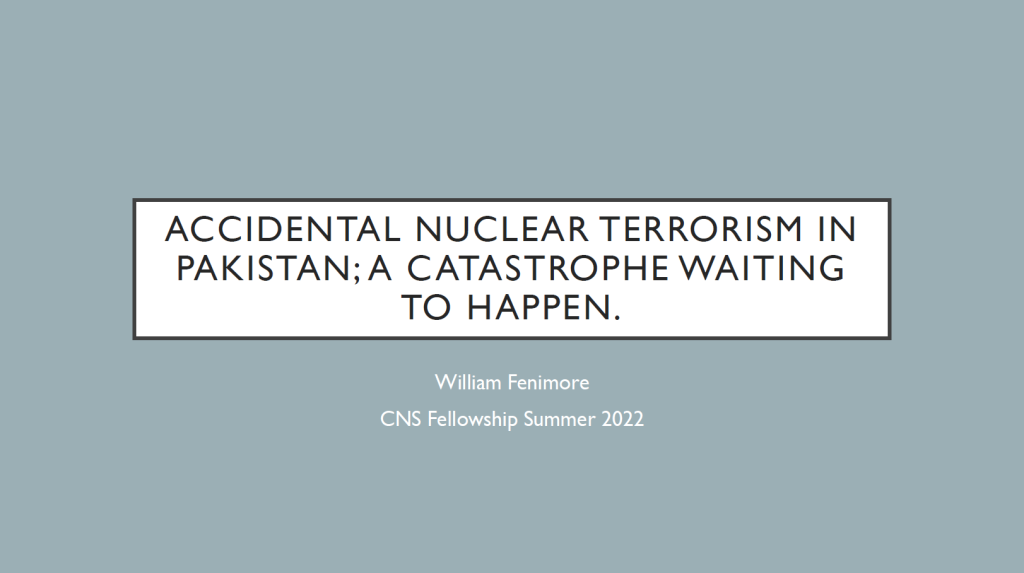
Nuclear Terrorism in Pakistan and its various faces have been studied extensively. It is not a new concept that terrorists may one day attempt to steal a nuclear weapon, make a nuclear weapon, or attack a nuclear reactor. However, one facet that has not been explored to the same extent, is inadvertent attacks on nuclear sites by terrorist groups, or accidental nuclear terrorism. Pakistan’s overall number of terrorism incidents has decreased significantly in the last ten years. However, the Balochistan Liberation Army, a Baloch ethnic group that mainly attacks military outposts, has been increasing the number and severity of their attacks. Because of the nature of the relationship between India and Pakistan, the Pakistan government usually accuses the RAW (India’s intelligence branch) of supporting terrorist groups like the BLA and aiding them in their exploits in Pakistan. Because of this link, true or untrue, between India and terrorist groups in Pakistan, if a nuclear base was attacked by a terrorist group, on purpose or by accident, Pakistan might treat it as a nuclear level threat by India. This could in turn lead to nuclear level tensions between the two states.
